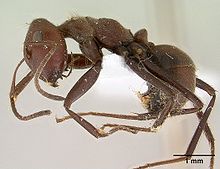Autothysis

Autothysis (from the Greek roots autos- αὐτός "self" and thysia θυσία "sacrifice") is the process where an animal destroys itself via an internal rupturing or explosion of an organ which ruptures the skin. The term was proposed by Maschwitz and Maschwitz in 1974 to describe the defensive mechanism of Camponotus saundersi, a species of carpenter ant.[1][2] It is caused by a contraction of muscles around a large gland that leads to the gland wall breaking. Some termites (such as the soldiers of Globitermes sulphureus) release a sticky secretion by rupturing a gland near the skin of their neck, producing a tar baby effect in defense against ants. It is a form of suicidal altruism.[2]
Termites
Groups of termite whose soldiers have been found to use autothysis to defend their colonies include: Serritermes serrifer, Dentispicotermes, Genuotermes and Orthognathotermes. Several species of the soldierless Apicotermitinae, for example those of the Grigiotermes and Ruptitermes genera, have workers that can also use autothysis. This is thought to be one of the most effective forms of defense that termites possess as the ruptured workers block the tunnels running into the nest and it causes a one-to-one exchange between attackers and defenders, meaning attacks have a high energy cost to predators.[2][3]
The soldiers of the neotropical termite family Serritermitidae, have a defense strategy which involves front gland autothysis, with the body rupturing between the head and abdomen. When outside the nest they try to run away from attackers, and only use autothysis when in the nest, to block tunnels up, preventing attackers entering.[4]
Old workers of Neocapritermes taracua develop blue spots on their abdomens that are filled with copper-containing proteins. These react with a secretion from the labial gland upon autothysis to form a mixture which is toxic to other termites.[5][6]
Ants
Some ants belonging to the Camponotus genus have adapted to using autothysis as an altruistic defensive trait in order to better fight against arthropods and to possibly deter vertebrate predators for the benefit of the colony as a whole. These ants use autothysis as a self-destructive defense to protect their territory, but they use it differently than termites do, in that their primary uses for autothysis do not include blocking the tunnels of their territory from attackers, but more so for combat purposes during territorial battles.[7][8]
Early ants used mechanical means of stinging to defend themselves, but the stings showed to be more useful against large vertebrate predators and not as successful against other arthropods. For this reason, there was selection for autothysis in ants as a way to effectively kill more arthropod enemies. The products of autothysis in ants are sticky and corrosive substances. These substances are released by the ants’ contraction of their gaster, leading to a burst at an intersegmal fold as well as the mandibular glands. The ants use this self-sacrifice to successfully kill one or more enemies by entangling themselves in this sticky substance. The worker ant has been observed to wrap itself around an opponent, placing its dorsal gaster onto the opponents face preceding the expulsion of sticky corrosive product from its mouth and gaster, permanently sticking to the opponent while killing itself and the enemy, as well as any other enemies that become stuck to the products.[1][7][8]
Using autothysis for these ants is mostly used against other arthropods, like invading ant colonies or against termite colonies and are rather ineffective towards larger vertebrate predators such as lizards or birds. This self-sacrifice is most useful against arthropods because the sticky adhesives in the products work best against the bodies of other arthropods. The compounds used in autothysis, however, have also been explained to have some use in deterring vertebrate predators from eating the ants, because these products are inedible. [9][10]
See also
References
- ^ a b Maschwitz, U.; Maschwitz, E. (1974). "Platzende Arbeiterinnen: Eine neue Art der Feindabwehr bei sozialen Hautflüglern". Oecologia Berlin (in German). 14: 289–294. doi:10.1007/BF01039798.
- ^ a b c C. Bordereau, A. Robert, V. Van Tuyen & A. Peppuy (1997). "Suicidal defensive behavior by frontal gland dehiscence in Globitermes sulphureus Haviland soldiers (Isoptera)". Insectes Sociaux. 44 (3): 289–297. doi:10.1007/s000400050049.
{{cite journal}}: CS1 maint: multiple names: authors list (link) - ^ Šobotník, J.; Jirošová, A.; Hanus, R. (2010). "Chemical warfare in termites". Journal of Insect Physiology. 56 (9): 1012–1021. doi:10.1016/j.jinsphys.2010.02.012. PMID 20223240.
- ^ ŠobotnÍk, J.; Bourguignon, T.; Hanus, R.; Weyda, F.; Roisin, Y. (2010). "Structure and function of defensive glands in soldiers of Glossotermes oculatus (Isoptera: Serritermitidae)". Biological Journal of the Linnean Society. 99 (4): 839. doi:10.1111/j.1095-8312.2010.01392.x.
- ^ Sobotnik, J.; Bourguignon, T.; Hanus, R.; Demianová, Z.; Pytelková, J.; Mareš, M.; Foltynová, P.; Preisler, J.; Cvačka, J.; Krasulová, J.; Roisin, Y. (2012). "Explosive Backpacks in Old Termite Workers". Science. 337 (6093): 436. doi:10.1126/science.1219129. PMID 22837520.
- ^ Nick Crumpton (2012-07-26). "Termites' crystal backpacks help them go out with bang". BBC News. Retrieved 2012-07-26.
- ^ a b Davidson, D.W.; Salim, K.A.; Billen, J. (2011). "Histology of structures used in territorial combat by Borneo's 'exploding ants'". Acta Zoologica. 93 (4): 487–491. doi:10.1111/j.1463-6395.2011.00523.x.
- ^ a b Jones, T.H.; Clark, D.A.; Edwards, A.A.; Davidson, D.W.; Spande, T.F.; Snelling, R.R. (2004). "The chemistry of exploding ants, Camponotus Spp. (Cylindricus Complex)". Journal of Chemical Ecology. 30 (8): 1479–1492. doi:10.1023/b:joec.0000042063.01424.28.
- ^ Shorter, J.R.; Reuppell, O. (2011). "A review on self-destructive defense behaviors in social insects". Insectes Sociaux. 59 (1): 1–10. doi:10.1007/s00040-011-0210-x.
- ^ Sands, W.A. (1982). "Agonistic behavior of African soldierless apico-termitinae (Isoptera, Termitidae)". Sociobiology. 7 (1): 61–72.
